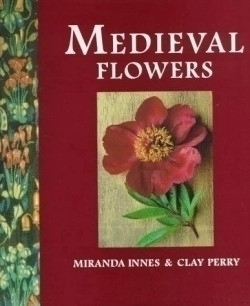Medieval Flowers
If the leaves be put beneath your pillow,
you will be well protected from
troublesome dreams and all mental anxiety.
So begins the section on “Rosemary,” but the advice fares well for the whole, pretty volume. This book is written in florid prose about the herbs and posies that healed and comforted the medieval man, complemented his love poetry, and disguised his unwashed body. Divided into sections according to the season, Medieval Flowers leads us by the nose through the world of smoky, thatched cottages and drafty castles. The Easter egg, spring tonics and housewives brightening up their wardrobes with herbal dyes are some of the topics covered in the first section. Lilies, roses and potpourri are for “High Summer.” Winter offers us the magic plants of ivy and mistletoe plus a recipe for quince wassail. There are also directions for making birch sap wine, tansy stir-fry, a salve for wounds from poisoned weapons, as well as how to spruce up your pease porridge.
The illustrations are delightful and varied using close-up photography of meadows, forests, reconstructed gardens, and reprints from prayer books and daybooks of the period. Appearing within the text and in tinted bands are quotations from almanacs and herbal books, some quite extensive and with the original spelling. The final section details 78 plants used in the medieval kitchen and medicinal garden. According to the authors, very few flowers were grown for their beauty alone; usefulness was a virtue, good looks an accident. This book has good looks and utility. Not just an herbal, it’s a pleasant and fascinating lesson in domestic history. Highly recommended.
Reviewed by
H. Shaw Cauchy
Disclosure: This article is not an endorsement, but a review. The publisher of this book provided free copies of the book to have their book reviewed by a professional reviewer. No fee was paid by the publisher for this review. Foreword Reviews only recommends books that we love. Foreword Magazine, Inc. is disclosing this in accordance with the Federal Trade Commission’s 16 CFR, Part 255.

